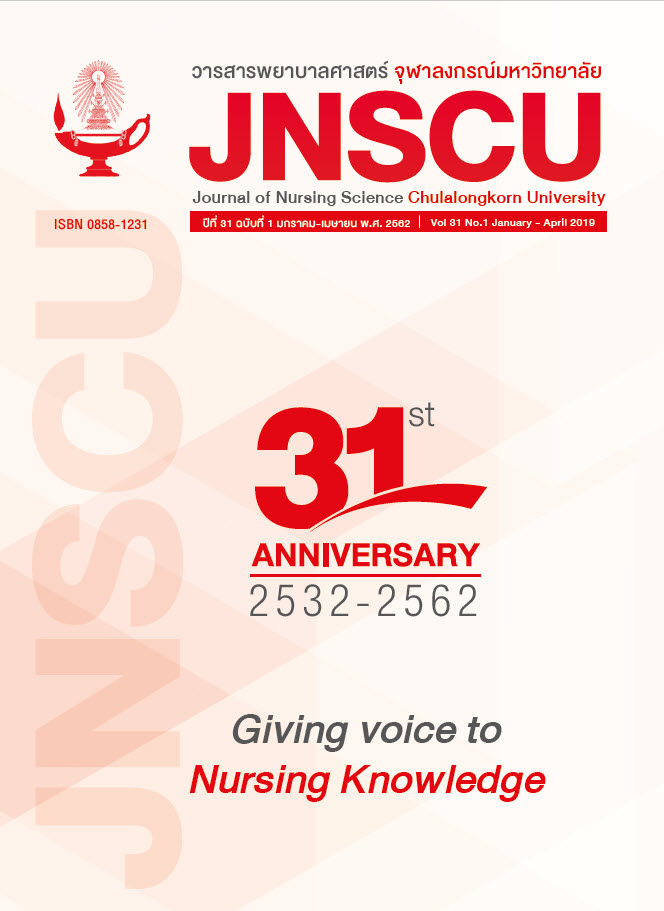ผลของบริการเลิกบุหรี่ของศูนย์บริการเลิกบุหรี่ ทางโทรศัพท์แห่งชาติ : การวิเคราะห์แยกเพศ
คำสำคัญ:
บริการเลิกบุหรี่, ศูนย์บริการเลิกบุหรี่ทางโทรศัพท์แห่งชาติ, ผู้สูบบุหรี่เพศชาย, ผู้สูบบุหรี่เพศหญิงบทคัดย่อ
วัตถุประสงค์: เพื่อศึกษาลักษณะทั่วไป พฤติกรรมการสูบบุหรี่ ความแตกต่างระหว่างเพศกับพฤติกรรมการสูบบุหรี่และอัตราการเลิกบุหรี่ ของผู้ใช้บริการเลิกบุหรี่จากศูนย์บริการเลิกบุหรี่ทางโทรศัพท์แห่งชาติ ด้วยรูปแบบบริการ 1) ข้อความสั้น 2) รับคำปรึกษาทางโทรศัพท์ และ 3) ข้อความสั้นร่วมกับรับคำปรึกษาทางโทรศัพท์
รูปแบบการวิจัย: การวิจัยกึ่งทดลอง
วิธีดำเนินการวิจัย: ผู้ใช้บริการเลิกบุหรี่ของศูนย์บริการเลิกบุหรี่ทางโทรศัพท์แห่งชาติ ตั้งแต่ 1 กันยายน พ.ศ. 2559 ถึง 28 กุมภาพันธ์ พ.ศ. 2560 รวมจำนวน 650 คน เลือกรับบริการเลิกบุหรี่ตามความสมัครใจ ได้แก่ บริการเลิกบุหรี่ด้วยข้อความสั้น จำนวน 143 คน, บริการเลิกบุหรี่ด้วยการรับคำปรึกษาทางโทรศัพท์ จำนวน 121 คน, และบริการเลิกบุหรี่ด้วยข้อความสั้นร่วมกับการรับคำปรึกษาทางโทรศัพท์ จำนวน 386 คน มีกำหนดวันเลิกบุหรี่ภายใน 30 วันข้างหน้า เก็บรวบรวมข้อมูลโดยการสัมภาษณ์ทางโทรศัพท์ กลุ่มตัวอย่างส่วนใหญ่เป็นเพศชาย (ร้อยละ 85.85) อายุ 25-44 ปี (ร้อยละ 43.38) ครึ่งหนึ่งของกลุ่มตัวอย่าง (ร้อยละ 55.69) สูบบุหรี่วันละ 11-20 มวน วิเคราะห์ข้อมูลโดยใช้สถิติเชิงพรรณนา การทดสอบค่าทีแบบอิสระ และสถิติทดสอบไคสแควร์
ผลการวิจัย: ค่าเฉลี่ยคะแนนการติดนิโคตินในกลุ่มตัวอย่างเพศหญิงสูงกว่ากลุ่มตัวอย่างเพศชาย อย่างมีนัยสำคัญทางสถิติที่ระดับ .05 (t=-2.22, p-value=.027) อย่างไรก็ตาม อัตราการเลิกบุหรี่ที่ระยะเวลา 7 วัน 30 วัน 3 เดือน และ 6 เดือน ทั้งเพศชายและเพศหญิงไม่แตกต่างกันอย่างมีนัยสำคัญทางสถิติ
สรุป: ผลการวิจัยชี้ให้เห็นว่าบริการเลิกบุหรี่ของศูนย์บริการเลิกบุหรี่ทางโทรศัพท์แห่งชาติมีประสิทธิผลเหมาะสมทั้งเพศชายและเพศหญิง จึงไม่มีความจำเป็นต้องออกแบบหรือพัฒนาบริการที่เฉพาะเจาะจงกับเพศ
เอกสารอ้างอิง
JhaP MM, ChaloupkaFJ,etal. Global HazardsofTobaccoand theBenefitsofSmokingCessationand TobaccoTaxes. In: Gelband H JP,SankaranarayananR,etal.,editor.Cancer: Disease ControlPriorities,Third Edition (Volume 3).Washington (DC):TheInternationalBankforReconstruction and Development / The World Bank;2015 Nov1. Chapter10. Availablefrom: https://www.ncbi.nlm.nih.gov/books/NBK343639/doi:10.1596/978-1-4648-0349-9_ch10.
Thipphayarangsarit S, Pankrajang P. Tobacco consumptionstatisticsreport inThailand 2018.Bangkok:Charoendee MunkongPrinting; 2018. (in Thai)
BundhamcharoenK, AungkulanonS, Makka N,Shibuya K. Economic burden from smoking-related diseases in Thailand.Tobacco control. 2016;25(5):532-7.
BureauofTobacco Control. National strategic plan for tobacco control 2014-2019. Bangkok:DepartmentofDisease Control,Ministry of Public Health; 2014.
RussoET,Reid M,TaherR,Sharifi M,ShahSN. ReferralStrategiestoaTobacco Quitline and Racial and/or Ethnic Differences inParticipation. Pediatrics. 2018;141(Supplement 1):S30.
ProchaskaJO,VelicerWF.TheTranstheoretical Model of Health Behavior Change. AmericanJournalof HealthPromotion.1997;12(1):38-48.
Yunibhand J, Chaiyawat W, Preechawong S, Rojnawee S. The quitrate among smokers with chronic illnesses who have received smoking cessation counseling from the Thailand National Quitline. Journal of Public Healthand Development. 2013; 11(2): 49-61. (in Thai)
Rojnawee S, Khongtor O, Preechawong S,Yunibhand J. Wongsaita N, Khamrath J.Predicting factors of smoking cessationamongsmokerscallingThailand NationalQuitline. Journal of Nursing Science & Health.2016; 39(1):37-47. (in Thai)
Allen AM,KrupskiL,Yuan NP, Nair U,Wertheim BC, Bell ML. Gender differences inutilization of services and tobaccocessationoutcomes at a state quitline.2018.
Heydari G, Jianfar G, Alvanpour A, Hesami Z,Talischi F, Masjedi MR. Efficacy oftelephone quit-linefor smokers iniran:12 months follow up results. Tanaffos.2011;10(3):42-8.
Marqueta A, NerinI, GargalloP,Beamonte A.Gender differencesinsuccessat quittingsmoking:Short-andlong-termoutcomes.Adicciones. 2016;29(1):13-21.
Li HCW, Chan SSC, Wan ZSF, Wang MP,Lam TH. An evaluation study of agender-specific smoking cessation
program to help Hong Kong Chinesewomen quit smoking. BMC publichealth. 2015;15:986-.
Rodgers A, Corbett T, Bramley D, Riddell T,Wills M, Lin RB, et al. Dou smoke aftertxt? Results of a randomised trial ofsmoking cessationusing mobile phonetext messaging.Tobaccocontrol.2005;
(4):255-61.
Chirawatkul S, Saito AS, Boonreong P,Srirahut J,Kongkird T.Beinga Male DrugUserand Female Drug User: MeaningofDrugs Use. J Psychiatr Assoc Thailand2013; 58(4): 407-420. (in Thai)
Abdullah ASM,LamTH, ChanSSC, Hedley AJ.WhichsmokersusethesmokingcessationQuitlinein HongKong,and how effectiveis the Quitline?Tobacco Control. 2004;13(4):415.
Myung S-K, Seo HG,Park EC, Lim MK,Kim Y.An observational study of the Koreanproactive quitline service for smokingcessation and relapse prevention.Publichealthreports (Washington, DC :1974). 2011;126(4):583-90.
Leventhal AM, Waters AJ,Boyd S, MoolchanET, Lerman C, Pickworth WB. Genderdifferencesinacutetobacco withdrawal:effects on subjective, cognitive, andphysiological measures. Experimentaland clinical psychopharmacology.2007;15(1):21-36.
ThiangthamW,KalampakornS, IntharanateT,Sornsin W. The life experiencesof Thaiwomen and smoking: a phenomenological study. Journal of the MedicalAssociation of Thailand = Chotmaihetthangphaet. 2013;96 Suppl 5:S55-63.
Lent AB, O’ConnorPA,ReikowskyRC, Nair US,Bell ML. Quit outcomes among clientsineligible for cessation medicationthroughthestatequitline:aretrospective,observationalstudy.BMC Public Health.2018;18(1):1001.
Ybarra M, Bagci Bosi AT, Korchmaros J,EmriS. A textmessaging-based smokingcessation program for adult smokers:randomized controlled trial. Journalofmedical Internet research. 2012;14(6):e172-e.
Fingrut W, Stewart L, CheungKW. Choiceofsmokingcessationcounsellingvia phone,text,oremail inemergency departmentpatients. Preventive Medicine Reports.2016;4:597-600.
ดาวน์โหลด
เผยแพร่แล้ว
ฉบับ
ประเภทบทความ
สัญญาอนุญาต
ลิขสิทธิ์ของบทความที่ตีพิมพ์เป็นของวารสารพยาบาลศาสตร์ จุฬาลงกรณ์มหาวิทยาลัย ทั้งฉบับตีพิมพ์เป็นรูปเล่มและเอกสารออนไลน์



